
The future of work in technology How technology leaders can reimagine technology work, the workforce, and the workplace
27 minute read
10 June 2019
The future of work in technology, encompassing work, workforce, and workplace, is undergoing a transformation. How can technology and business leaders strategize, design, and collaborate to succeed in this journey?
Evolving strategic business imperatives, trends, and disrupters are driving a seismic shift in the way IT organizations operate. This report—part of a series exploring the merger of business and technology strategies and the reimagination of technology’s role in the business—aims to address fundamental questions about the future of work in technology:
How can organizations leverage technology to redesign current work outcomes to focus on exponential increases in productivity and cost efficiencies and redefine new work outcomes that extend beyond productivity and cost to value, meaning, and impact?
How will tomorrow’s technology workforce be different than today’s? How will jobs and roles change? What skills and capabilities will be needed?
Does the current workplace support the evolving work of technology and the workforce required to complete it? How will it need to be redesigned to sustain the evolution of technology work?
Learn more
Explore the CIO Insider collection
Learn more about the Future of Work
Subscribe to receive related content from Deloitte Insights
Based on formal surveys and interviews with dozens of business and technology leaders, this report discusses the future of work in technology—the work itself, who does the work (workforce), and where the work is done (workplace).1 It sheds light on changes in these three dimensions—work, workforce, and workplace—that have already begun, will continue to unfold during the next three years, and likely will continue to progress over time. Finally, it will provide pragmatic advice and recommendations on how technology and business leaders can strategize, design, and collaborate on this bold journey.
Reimagining the role of technology
Savvy business and technology executives are working together to reimagine how technology delivers business value and competitive advantage. “Because of technological advances, technology’s role within the organization is itself shifting,” says Satish Alapati, CIO of Media & Entertainment Customer Experience at AT&T. “The role of technology has evolved from automating the business to actually being the business.”2
Business innovation and disruption are rapidly changing the scope, pace, and scale of technology work. “Disruptions come in different forms—from competitors using technology at scale to the industrial Internet of Things,” says another technology leader. “As a result, it’s becoming more important than ever to enable everything we do with cutting-edge technology.”3
Yet despite the convergence of technology and business strategies, data from Deloitte’s 2018 Global CIO Survey suggests that CIOs and other technology leaders still struggle with a lingering perception of IT as order-taker rather than business-driver. Only 29 percent of business leaders participating in the survey agree that the technology organization and its leaders should be deeply involved in developing enterprise business strategy.4
Four major shifts in the role of technology
Deloitte’s ongoing research on reimagining the role of technology has identified four significant shifts that are changing the role of technology in organizations.
From trusted operator to business cocreator. Technology teams should continue to maintain operational excellence—in the past, their primary function—but because business and technology strategies are now entwined, technology work should evolve to focus on hand-in-hand collaboration with business functions to cocreate value.
In addition, because of the growing demand for rapid and efficient delivery of low-friction experiences and capabilities—on par with best-in-class consumer-grade online experiences—many technology teams are shifting from traditional project- and process-focused operating models to those that are more product- and outcome-centric, which prioritize cross-functional collaboration, acceleration of time-to-customer value and other user/customer needs, and business outcomes.
From service delivery to value delivery. Automation, cloud, and as-a-service technology models are taking root, streamlining and speeding IT delivery, and changing the way technology teams and business functions work, collaborate, and create value. And they’re helping eliminate some tactical and operational work and move the rest to machines and service providers.
As technology teams shift from trusted operators to business cocreators, their worth likely will lie in the value they deliver to the business rather than in the services they deliver.
From cost center to revenue engine. In the service delivery world, IT is typically viewed as a cost center, with CIOs charged to deliver services at the lowest possible cost. The average IT department invests more than half (56 percent) of its technology budget on maintaining business operations and spends only 18 percent on building new business capabilities.5
Data suggests that if technology teams are to drive innovation and be change agents, reducing costs should take a back seat to strategically investing to increase revenue, growth, stock price, or other measurements of business and shareholder value. CIOs in “digital vanguard” organizations—those with well-defined digital strategies and highly regarded IT departments—already allocate less than half of their budgets (47 percent) to business operations and 26 percent to innovation. In the next three to five years, they plan to further reduce the operations allocation to a third of their annual budget while increasing innovation funding to 38 percent.6 For CIOs, being savvy about financial returns and articulating the value of technology investments can help drive forward their new agenda.
When technology and business strategies merge, the technology function is a codriver of innovation and cocreator of revenue driven by technology investments. “IT needs to demonstrate an innovation agenda,” says Jo-ann Olsovsky, Salesforce CIO. “A company has to feel that IT is a change agent that’s positioning the business for the future.”7
From cybersecurity to risk and resilience. When it comes to risk, technology leaders’ primary focus has been cybersecurity. While cybersecurity will always be critical, leaders also should focus on business resilience and risks and disruptions inherent to having a combined business-technology strategy—risks whose reach extends beyond traditional IT environments into factories and other workspaces, products, and even customer locations. Because digitally connected customers will now have access to data through a voluminous set of channels that all need to be secure and resilient, this should include integrating security into product design and development.
Forces shaping the future of work in technology
Technology’s transition to a new role in the organization requires the work of technology to change. Three forces are converging to reshape the future of work in technology:
The proliferation of disruptive technologies is continually reshaping businesses, industries, and markets.
Technology’s role is shifting to that of a catalyst for business strategy and transformation, changing the expectations and delivery of technology and blurring the lines between business and technology functions.
Global demographic and workforce trends such as gig and contingent workers, a multigenerational workforce, more diverse talent, and global talent markets are transforming the labor market in general—and the technology workforce in particular.
In the face of these drastic shifts, many savvy CIOs and other technology leaders are aiming to shape the future of work in technology. To do so, they can harness these forces and balance their competing demands while continuing to maintain operational excellence, meet business and customer expectations, and drive innovation, disruption, and digital transformation.
Traditional IT disciplines evolve to new technology disciplines
Many technology leaders recognize these shifts are happening but may fail to understand their fundamental implications on technology work and the workforce and workplaces required to deliver it. As a result, some leaders have approached the evolution to the future of work with disjointed, ad hoc efforts.
These changes have rendered the traditional scope of IT work unsustainable. Business leaders should redefine technology work beyond IT and refresh traditional IT disciplines to create technology disciplines focusing on value creation (figure 1). In this report, we deliberately replaced the acronym “IT” with “technology” because the scope of responsibility is very different for each. IT refers to the historic technology organization and its inward-focused IT disciplines. In the future, technology work will spread throughout the enterprise and may not be directly controlled by the CIO. Business and technology leaders alike can benefit from becoming comfortable with the idea of looking at technology holistically across the organization.
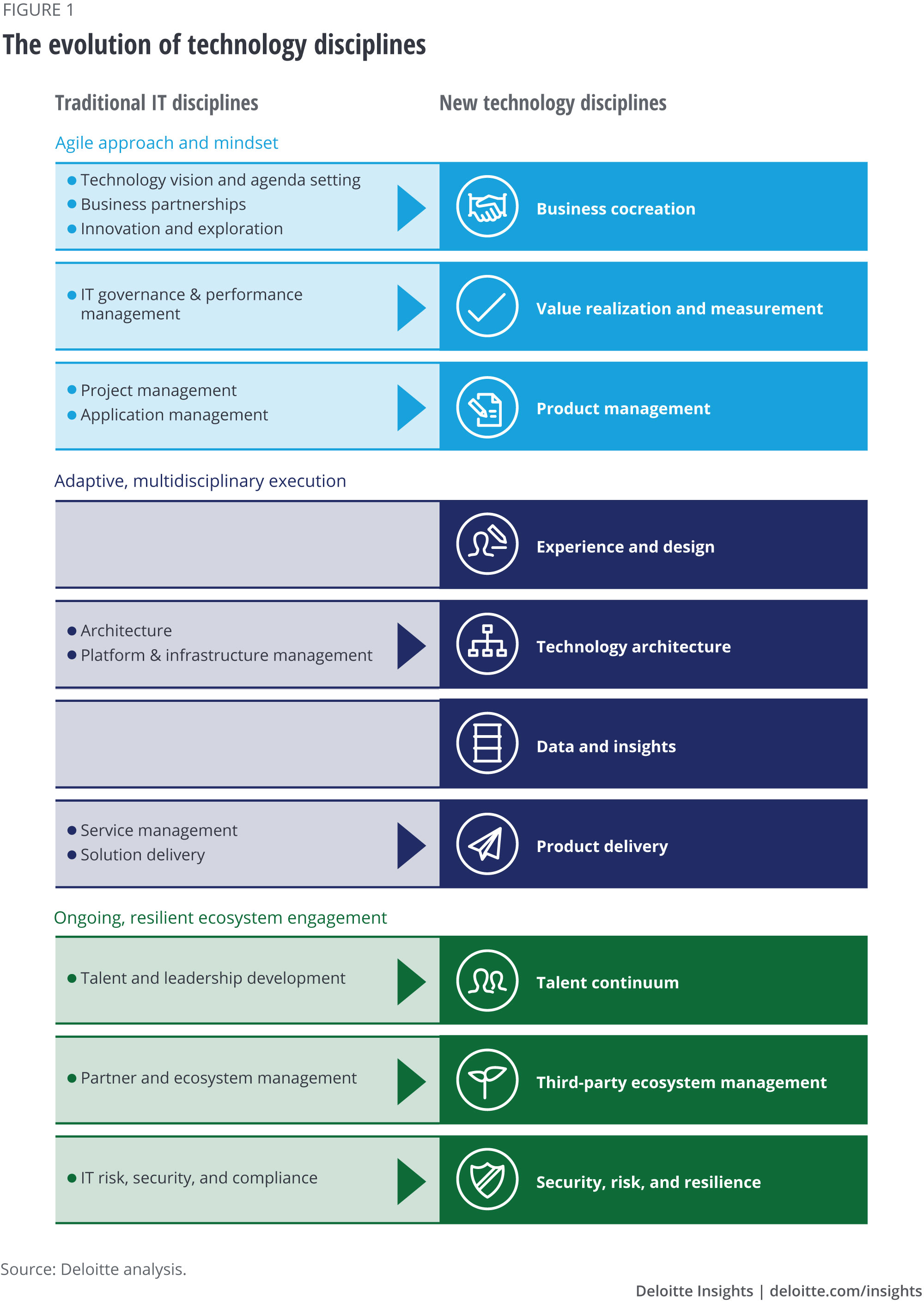
This evolution goes beyond semantics. New technology disciplines represent more than simply a different way of operating. Collectively, they define a fundamentally new type of work that extends beyond the boundaries of the technology organization to business and functional areas (see sidebar, “New IT disciplines”). Ultimately, these new disciplines can help transform the technology work, workforce, and workplace.
New IT disciplines
Business cocreation. Business cocreation is a shift in the role of the technology function from supporting character to costar. Hand-in-hand with business functions, technology teams can drive innovation and cocreate products, services, and experiences that drive growth, revenue, and competitive advantage. This likely will require unprecedented levels of collaboration among business and technology functions during the design, development, and deployment of products and services.
Value realization and measurement. The future of work in technology likely requires traditional IT governance and performance metrics to evolve to focus on realizing and measuring value. Clearly articulated business goals can provide clarity on objectives and metrics. KPIs such as revenue, market growth, and customer satisfaction can help monitor overall progress, maintain business-technology alignment, and keep teams jointly accountable.
Product management. When a product mindset is applied to the traditional IT disciplines of application and program management, technology work can be viewed as a product that solves business problems, rather than a project that implements an application and delivers functionality. This can ensure development of a coherent product strategy, a coordinated plan for spreading technology work across business and functional areas and external partners, and engagement with external stakeholders—including customers, prospects, and ecosystem partners—throughout the product development process.*
Experience and design. This new technology discipline focuses on tasks such as embedding technology into the end-to-end customer life cycle to provide products and solutions throughout the customer journey and help ensure that critical bottlenecks are quickly identified and resolved. Analytics and AI can help predict user behavior and provide a differentiated experience, thereby enabling revenue growth: Revenues for companies whose customer experience is highly ranked outgrew other companies by more than five to one, suggesting that technology leaders should actively engage in customer experience and design to provide this edge.
Technology architecture. Architectural discipline is often a casualty of rapid growth. Mergers and acquisitions, aging legacy systems and processes, and the proliferation of data and applications also can complicate and strain architecture, platform, and infrastructure management. Decisions about cloud adoption or off-the-shelf software purchases can be evaluated not only on cost, features, and functionality but also on their ability to offer future options, flexibility, agility, scalability, and speed to market.
Data and insights. Customer data can increase engagement and helps team create products and experiences to support individual customer journeys. Business data can improve decision-making, while product data can be monetized or used to help improve reliability and experience. Yet data on its own does not drive value—it first should be normalized, aggregated from across the organization and external sources, and analyzed to deliver insights that can be monetized. Few organizations have cracked the code for monetizing data, an even more challenging task because of the velocity at which data is being generated.
Product delivery and operations. Continuous delivery can enable faster, more iterative delivery of technology work, with continuous attention on improving quality. This likely includes migrating to approaches such as Agile development and DevOps to deliver greater, faster business value. Because legacy environments often use a mix of delivery methods, many organizations that shift to these methods may employ a hybrid approach.
Talent continuum. Talent of the future likely will be valued not only for technical skills but also for agility, flexibility, ability to collaborate, and other soft skills. To access needed skills, leaders may need to leverage talent from across the open talent continuum, which includes full-time and contract workers, crowdsourcing, and the external partner ecosystem. In addition, the talent continuum will include human–machine collaborations and partnerships. Businesses will rely on machines to carry out and augment work across a wide spectrum, where machines could serve as tools, assistants, peers, or even managers.8
Partner and ecosystem orchestration. Via engagement with the broader business ecosystem, leaders can tap new revenue sources such as business and industry platforms and digital marketplaces. Ecosystem partners can help organizations identify and understand emerging technologies that may be relevant to business strategy and objectives. Finally, engaging the ecosystem accelerates opportunities for learning, a largely social activity, and innovation, which is often the result of collaboration across fields of expertise and domains of knowledge.
Security, risk, and resilience. The historic IT risk, security, and compliance discipline typically is not designed to help companies evaluate, manage, and harness risks related to growth. Many savvy organizations are already managing such risks by using AI to protect against a rapidly changing threat landscape, managing risks to customer and company data and intellectual property used for value creation, bolstering organizational resilience to meet the requirements of a hyper-connected era, and owning digital responsibility and ethics.
*Product marketing is an important component of this discipline: It includes market positioning, creation of customer personas, product launches, sales strategy development (for internal products, development of consumption strategy, among others).
Three interrelated dimensions: Work, workforce, workplace
These external forces and internal pressures fundamentally redefine the three dimensions of the future of work in technology: the what (work), who (workforce), and where (workplace) of technology work, as shown in figure 2.
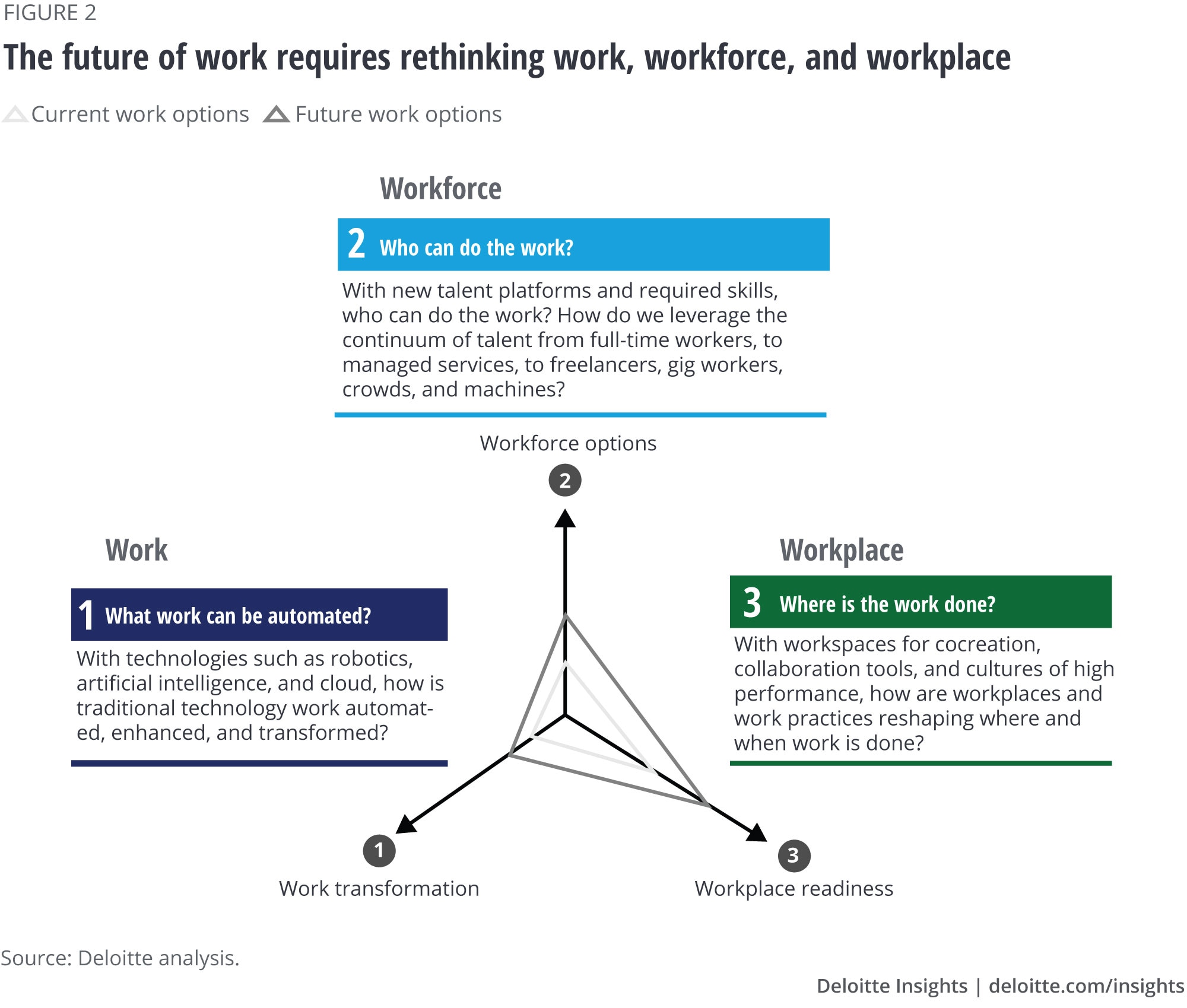
Every company’s journey to the future of work will have a different starting point depending on business strategy, industry drivers, and market dynamics. However, regardless of entry point, businesses should first define new work and work outcomes before considering workforce or workplace transformations.
Work (what): It’s likely that technology work increasingly will be performed by humans, machines, or human–machine collaboration; leaders should determine how to deploy people, bots, and algorithms separately and in partnership. Technology teams’ focus should turn from IT capabilities to work outcomes as they move from project- and process-centric operating models to those that prioritize products and outcomes. Cocreating value with business functions and focusing on customer outcomes rather than processes are part of a more fundamentally human and meaningful work experience. As teams shift their emphasis to combined business-technology strategies and objectives and are enabled by automation to trade manual and repetitive tasks for those requiring higher-order skills, it’s likely that they’ll find more meaning in their work.
Workforce (who): Jobs and roles, talent and skills, and organizational structure will evolve. Employment models are already changing; businesses can access talent via a range of on- and off-balance sheet solutions. And finally, instead of being specialized technologists, technology workers can become collaborative cocreators of business value.
Workplace (where): Technology workplaces are evolving from location-centric to relationship-oriented. The geographic location of the work will vary, and workspaces should be redesigned to maximize collaboration, productivity, and cocreation. When extended to a network of geographic locations, including virtual offices, coworking spaces, and traditional office spaces, seamlessly integrated technologies such as collaboration and digital reality tools can help facilitate and support connections among humans and machines.
Let’s take a more detailed look at the shifts in the work, workforce, and workplace.
Work: From IT capabilities to technology work outcomes
Historically, technology teams took pride in developing and delivering IT capabilities to serve business needs. Technology leaders assessed and developed people, processes, and technologies to address organizational demands through the use of complex capability models and frameworks—all within a centralized IT organization.
As organizations develop joint business-technology strategies and collaborate to cocreate business value, processes and roles may change, causing skills and tasks to overlap across traditional business and technology borders. Integrating business and technology skills and teams likely will require CIOs and other functional leaders to rethink how they and their teams work. The focus is no longer on the delivery of a project but on the value delivered from the outcome. “Redefining work means identifying and addressing unseen problems and opportunities in the work, for everyone at all levels and at all times,” says John Hagel, cochairman for Deloitte LLP's Center for the Edge.9
The transition from IT capabilities to technology work outcomes requires a fundamental shift in thinking: Technology is not solely the purview of the IT function. Business leaders are equally accountable for the successful design and delivery of technology work.
The two-step process of reimagining what technology work will look like in the future includes first deconstructing the work and identifying work outcomes, and then defining the roles that support new disciplines.
Step 1. Deconstruct the work and identify work outcomes
To gain clarity on the new work and provide guidance to those in new roles, technology leaders can deconstruct the work into work outcomes for each discipline. These outcomes will define not only the new work, but also the expected outcomes and accountabilities (figure 3).
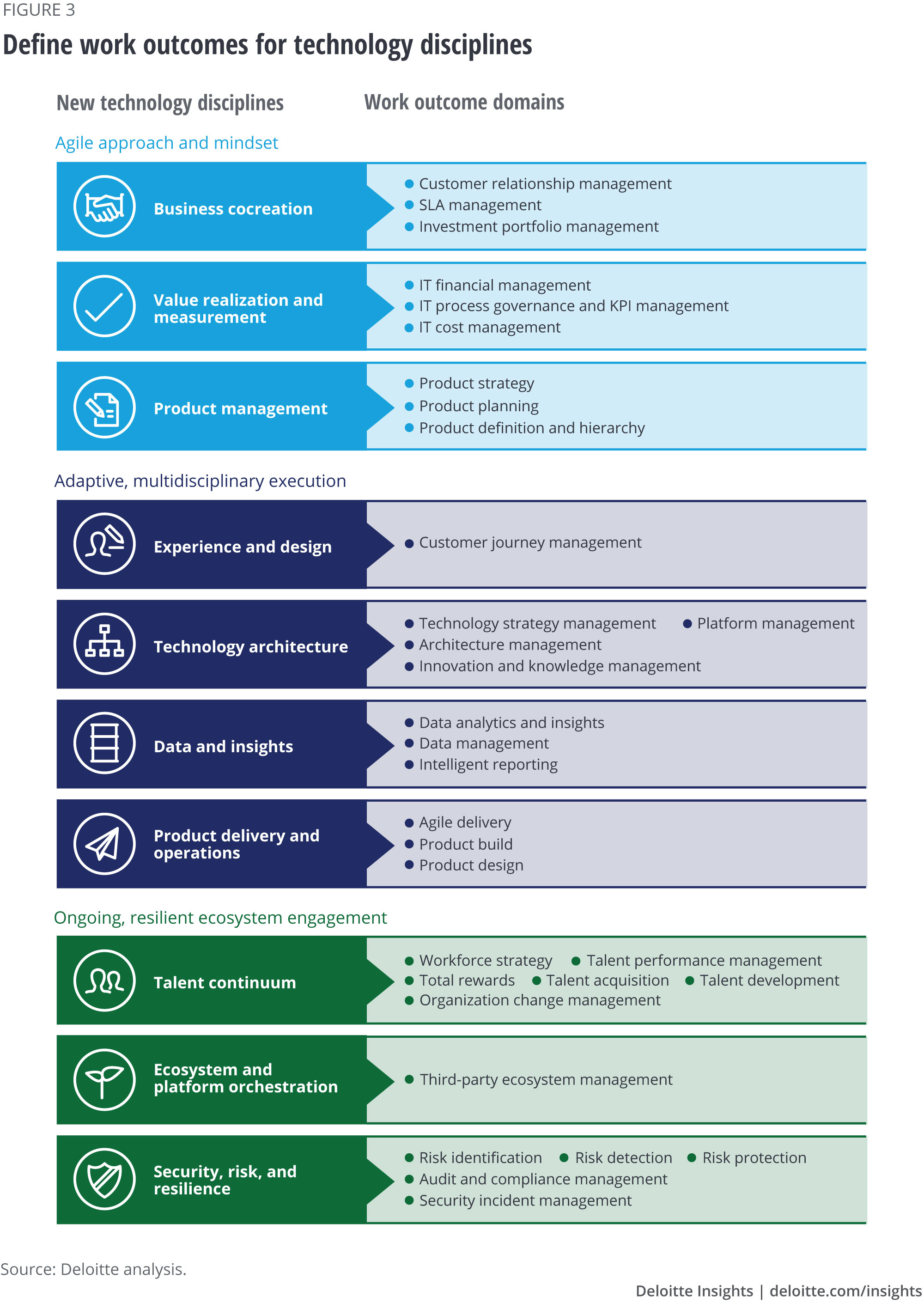
Further analysis of work outcomes can help determine which activities an organization should continue, discontinue, or deliver in a different way based on the changing role of technology. It can also help executives identify the work that will be performed by humans, machines, or a combination of the two—and help ensure that work is meaningful to all stakeholders.
This level of detail can help provide a deeper understanding of how work is changing and show how the roles and the organization could evolve to deliver the work. For example, a more in-depth examination reveals how the work outcomes for the technology disciplines of product management (figure 4) and product delivery and operations (figure 5) could be defined.
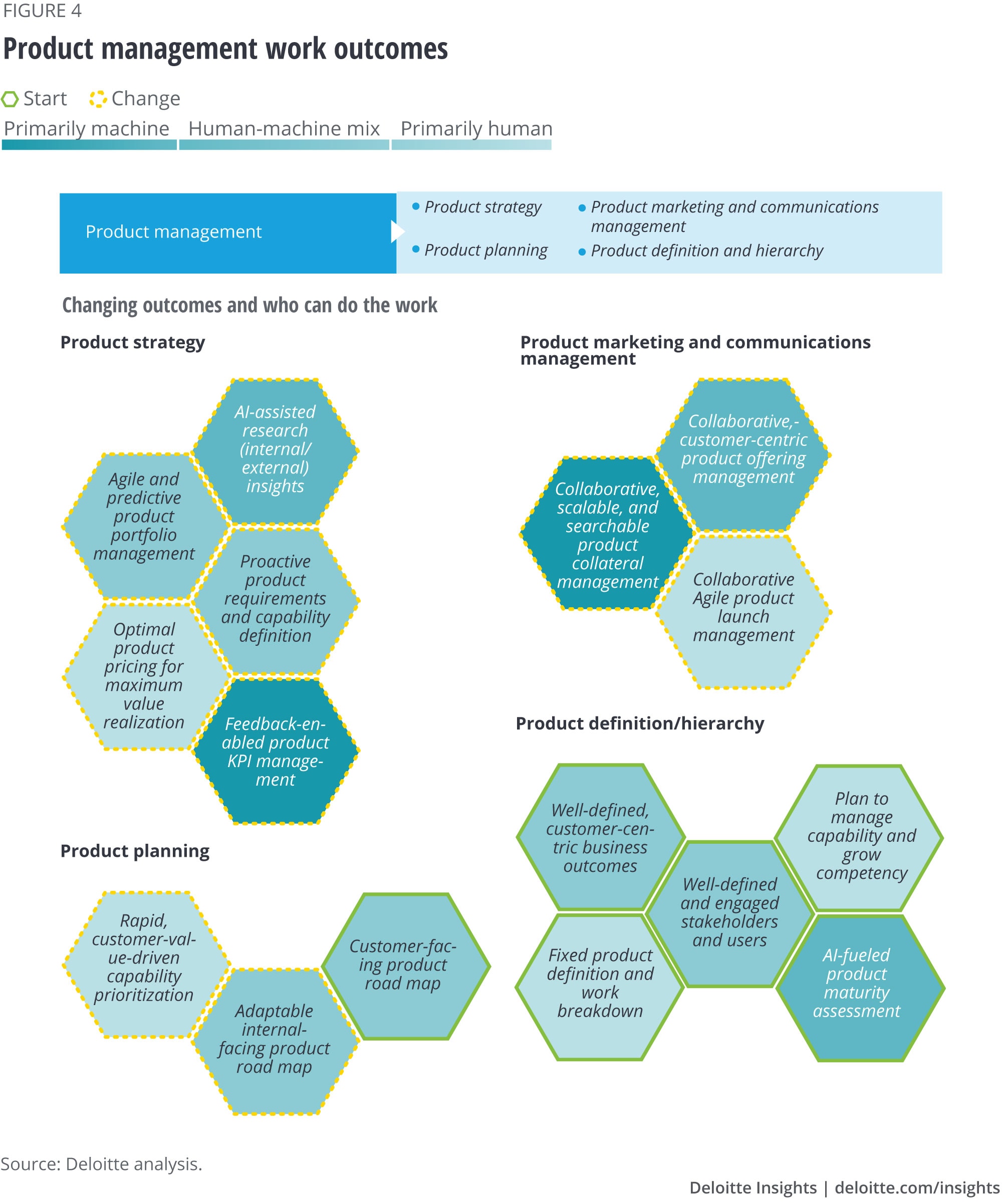
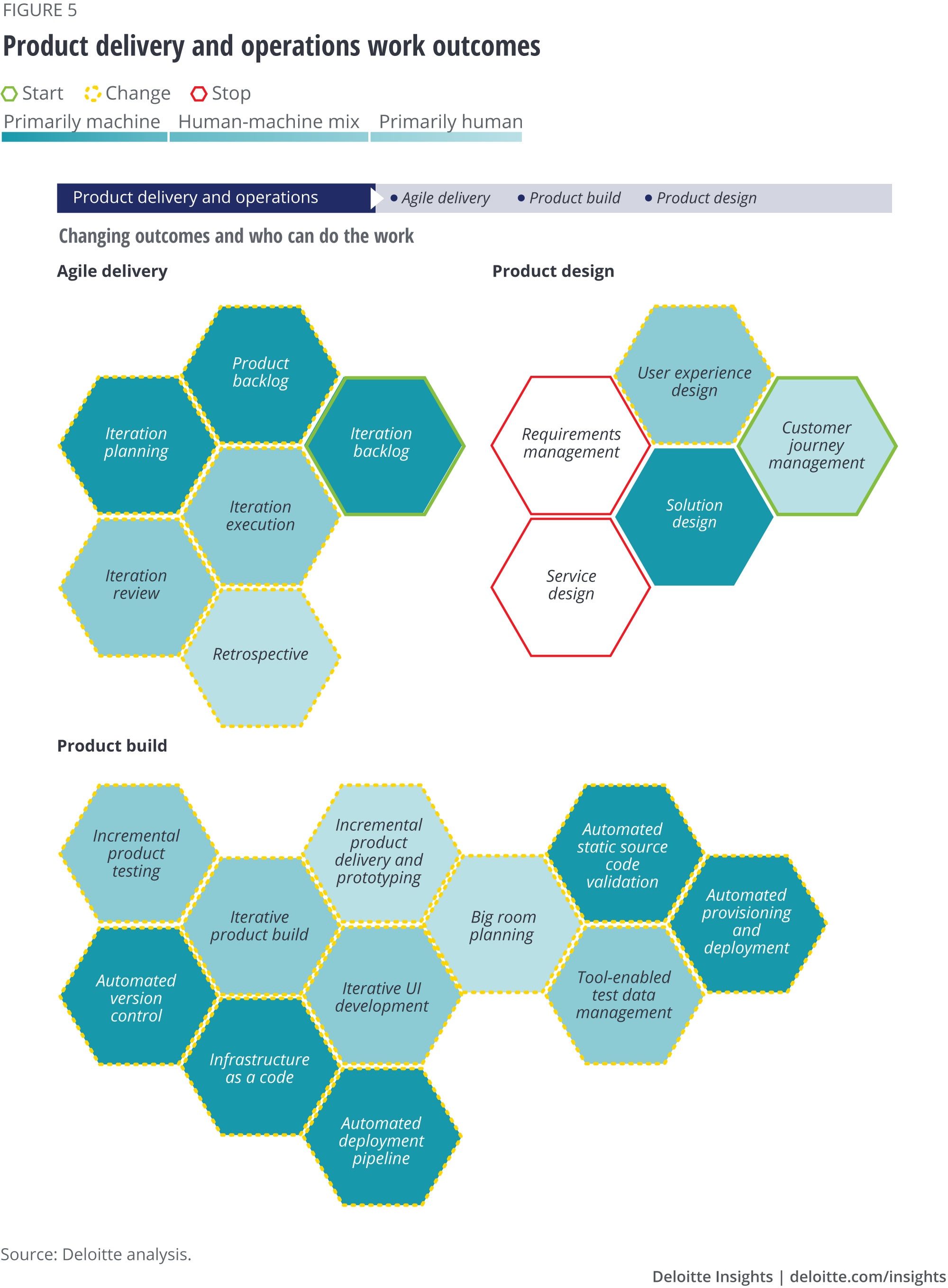
Step 2. Identify roles that support new disciplines
Once work outcomes have been designed, leaders can establish the organization and roles needed to support the new disciplines and outcomes. New roles will emerge but others, such as project manager and business analyst, may evolve, decline in demand, or even disappear (figure 6). Some roles, such as product owner, may be filled by workers in business functions rather than those in the technology function.
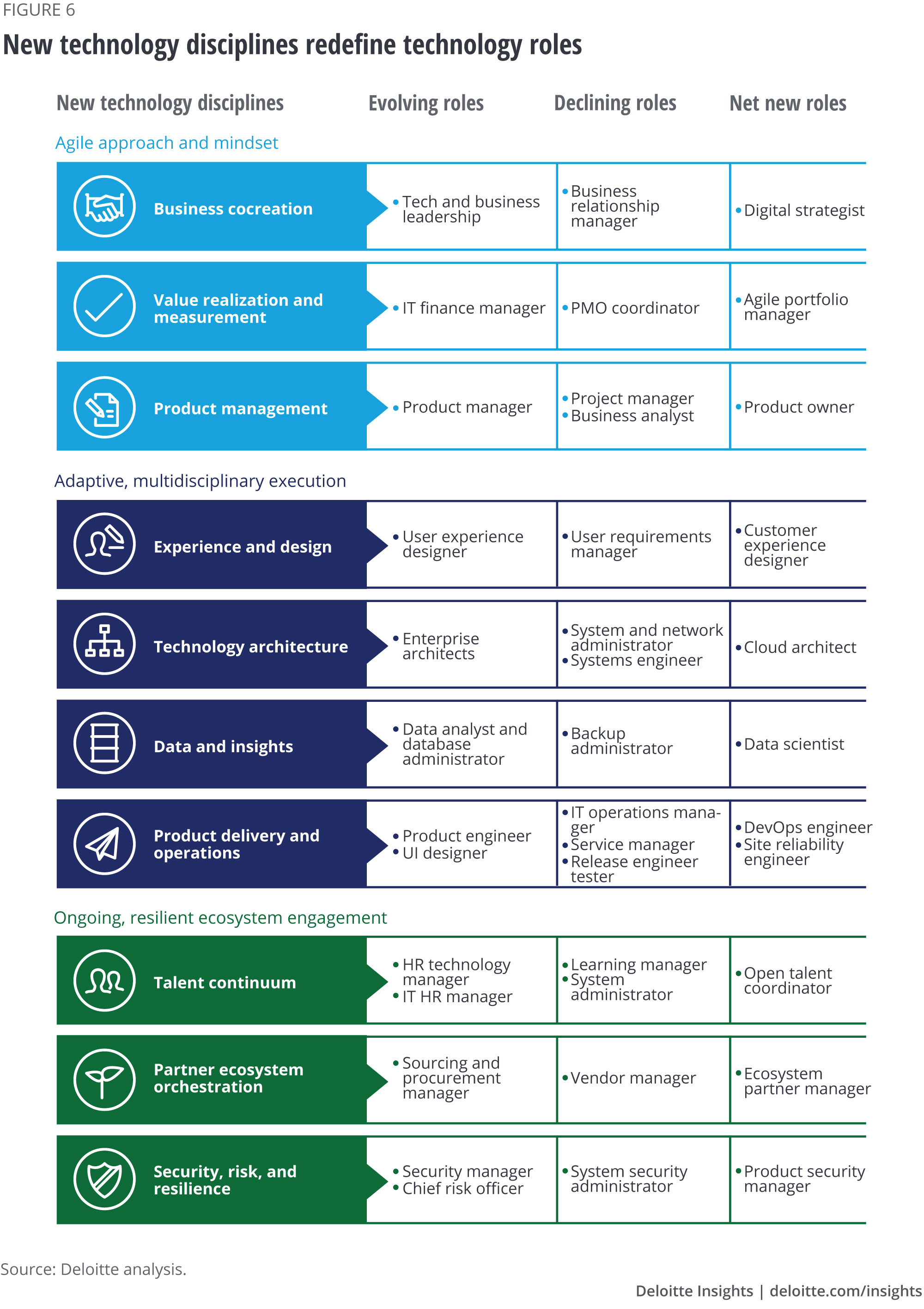
Leaders can identify roles that do not transfer to the new model and determine how resources can be reskilled, trained, and supported to make the shift. The vast majority (89 percent) of surveyed technology executives plan to somewhat or very extensively retrain current staff,10 but not all employees will want or be able to transition roles—for example, some project managers may not be able to become scrum masters. Defining clear work outcomes and accountabilities can allow leaders to have candid conversations with technology and business staff about future expectations.
Clarity of roles and organization structure to support the new disciplines can help leaders make a smooth transition. For example, the average technology organization might have hundreds of project managers and application developers. Executives can understand, assess, and communicate the new skills and tools these roles will need, and identify individual road maps based on current competencies, future potential, and passion.
Workforce: From specialized technologist to collaborative cocreator
The workforce required to deliver these new work outcomes could be a gating factor in this transition. As technology work evolves, talent with the required skills and capabilities are increasingly in high demand. The size, scope, and competencies of the workforce required to deliver the new technology work likely will be very different than in the past.
Some leaders begin considering workforce transformation without first determining the work and work outcomes that should be delivered. However, the lack of clearly identified and articulated work outcomes can lead to piecemeal, inefficient, and unproductive efforts. It bears repeating that business and technology leaders should first define new work outcomes—only then can they make determinations about transforming the workforce. The following considerations may help.
Technology athletes replace specialized technologists
As technology work changes, so do the skills and proficiencies required to complete the work. Fifty-one percent of CIOs surveyed in Deloitte’s 2019 report on Industry 4.0 readiness cite a significant mismatch between current skill sets and future needs.11
In the past, many IT workers have been task-focused, often with highly specific skill sets. A worker with sought-after application development skills could spend his or her entire career within a single specialization. Technical expertise remains critical and in short supply—65 percent of global CIO survey participants say analytics and data science will be the hardest-to-find technical skills in the next five years while 54 percent named cyber and 49 percent named emerging technologies.12
However, some specialized skill sets are falling by the wayside as IT becomes more automated. “Twenty years ago, people branded themselves as SAP experts and even focused on a specific module, and that was going to be the focus of their entire IT career,” says Wayne Shurts, former EVP and CTO, Sysco Corporation. “Those days are gone. Today it’s about technology athletes—people who are curious and are always looking to solve business problems through technology.”13
Ditto, says Rachel Parent, MassMutual CIO. “It’s no longer imperative that the IT leader be deeply skilled in a specific technology discipline. Technology is changing too rapidly for that depth of expertise to remain relevant,” she says. “There’s incredible value in having skills that allow you to keep current with technology trends. Understand which of those can help drive your organization’s strategy relative to serving customers, enabling collaboration, and increasing operational and financial efficiencies.”14
Machines augment tech workers
With clearly articulated work outcomes, technology leaders should be able to align roles and work. They can ascertain the outcomes that can best be achieved by machines, humans (permanent employees, contractors, or otherwise sourced), or a combination of both.
“It’s important to think about how people and machines should work together,” says Dell CHRO Steve Price. “This will have implications for how and where work gets done, the kind of skills people need to possess, and the broader expectations of the future workforce.”15
While cognitive technologies are indeed transformational, evidence suggests they will augment rather than replace workers.16 Most tactical, algorithmic, and structured work will be automated by machines over time, leaving much creative and strategic work for human talent. “We have spent way too much time thinking about people versus computers, and not nearly enough time thinking about people and computers,” says Thomas Malone, director of the MIT Center for Collective Intelligence. “We’ve spent too much time thinking about what jobs computers are going to take away from people, and not nearly enough time thinking about what people and computers can do together that could never be done before.”17
Enduring human skills complement technical expertise
In the past, soft skills that support collaboration and communication typically took a back seat to specialized technical skills. Today, soft skills are having a breakout moment. These enduring, essentially human skills are increasing in value in part because they cannot be replicated by machines.
Even though future technology jobs may be more machine-powered and data-driven, talent likely will need to have more breadth across both business and technology areas. This could include critical traits for driving innovation and disruption, such as:
- Business and financial acumen to understand complex business challenges and decisions
- Ability to understand the engagement, interaction, and collaboration of humans and machines
- Enduring and essential human skills such as empathy, creativity, and enthusiasm for learning
- Ability to embrace change and uncertainty
And as we’ve suggested, rather than working in centralized silos of IT expertise, technology talent likely will need to collaborate with business functions to cocreate value. The CIOs who participated in the global CIO survey point to a growing need to augment technical expertise with collaboration skills (figure 7).
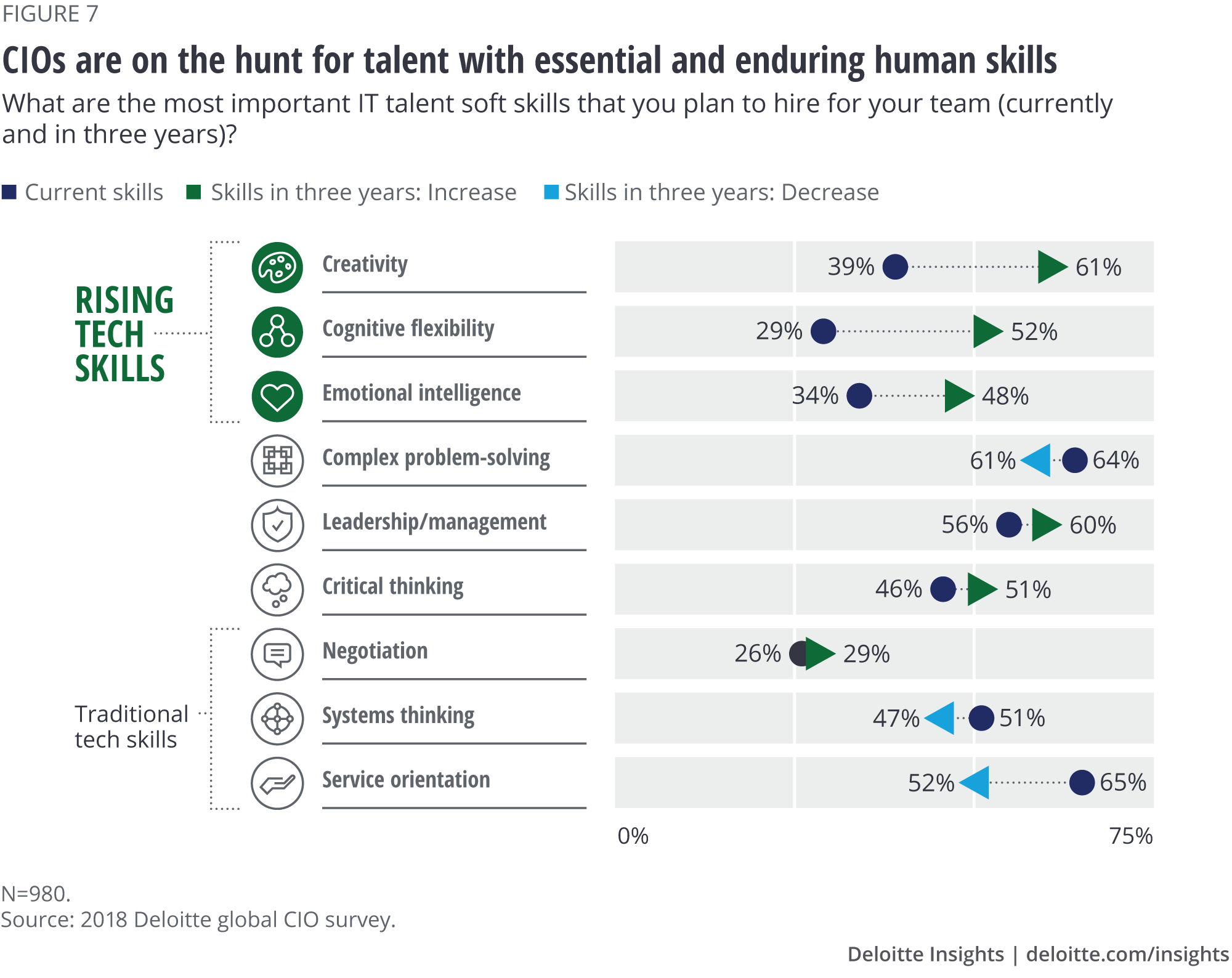
This is not a subtle shift—it likely requires new job families, roles, and talent capabilities. Talent shortages are hardly new to IT—60 percent of participants in the global CIO survey report difficulty finding employees with the appropriate balance of skills.18 Yet there likely will continue to be a dearth of talent with the right mix of specialized skills, adjacent proficiencies, and enduring human skills to support business mandates for innovation, growth, and business transformation.
Open talent continuum provides more workforce options
CIOs have more options than ever before to access the technology talent they need. The pool of potential tech workers—an open talent continuum—is expanding to include both on- and off-balance-sheet talent, from traditional full-time employees and managed services to alternative workers, including independent contractors, gig workers, and crowdsourcing (figure 8 ).19
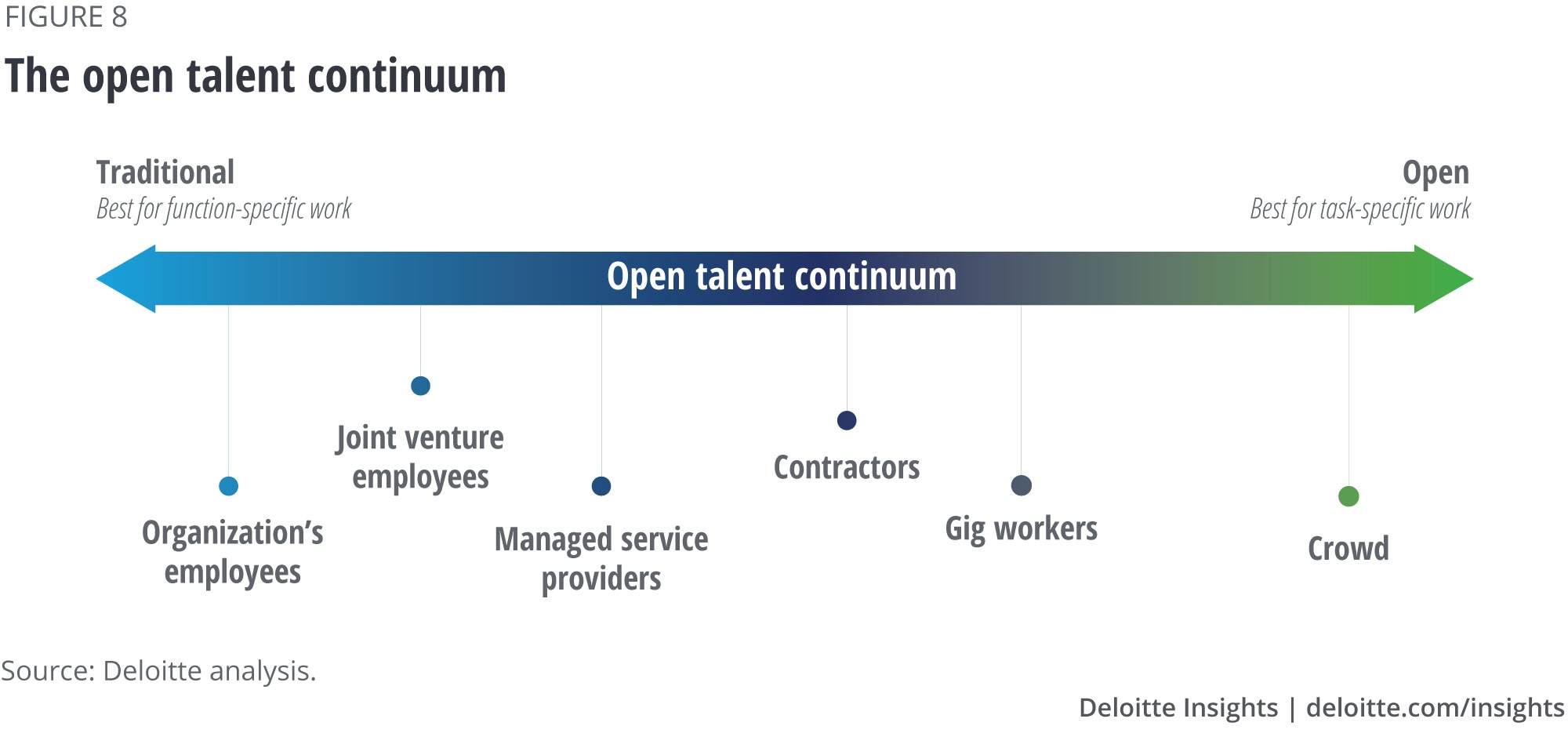
According to the global CIO survey, CIOs are already leaning heavily on the open talent continuum. Fifty-eight percent of survey respondents say they are retraining and retooling current talent.20 The same percentage report leveraging talent from external partners and service providers,21 and in another survey, 73 percent of technology executives said they plan to access needed talent by somewhat or very extensively using gig economy workers.22 Yet, a third of leaders surveyed for this report feel unprepared to leverage gig workers, freelancers, and crowdsourcing—a barrier that likely will need to be overcome.23
While technology organizations are adept at managing technology vendors, the 2019 Deloitte Global Human Capital Trends Survey found nearly half (49 percent) of IT organizations are not consistent or integrated in their methods for sourcing and managing talent across the open talent continuum, which can prevent organizations from accessing the needed talent from the best source in a timely manner. Nearly every survey respondent indicated HR is responsible for hiring and developing full-time employees while procurement handles contracts with the external ecosystem, and users across the organization access open talent sources such as contractors, gig workers, and crowdsourcing.
Job descriptions become job canvases
Job descriptions rarely match actual jobs, especially in technology—and the future of work in technology could be the nail in the coffin of the traditional job description. Future technology jobs will be ever-evolving and dynamic. The half-life of a skill is currently five years24 and likely will continue to decrease, which means the tools, skills, competencies, and requirements needed to perform a role will constantly change. People are likely to have multiple roles within an organization during their careers.
As a result, we propose evolving job descriptions into “job canvases” that outline expanded responsibilities, new skills, redesigned work, and redefined work outcomes that are the result of automation and machine augmentation. A job canvas could include:
- Skills increasing and decreasing in importance for that particular family of jobs
- Broad sets of responsibilities across a family of jobs
- Persona of an individual worker in the job
- Description of “a day in the life” of a person in the role
Building on the work outcomes examples, we identified potential changes to product management and product delivery and operations, examined how this could affect the roles of product manager and Agile portfolio manager, and developed sample job canvases for these roles.
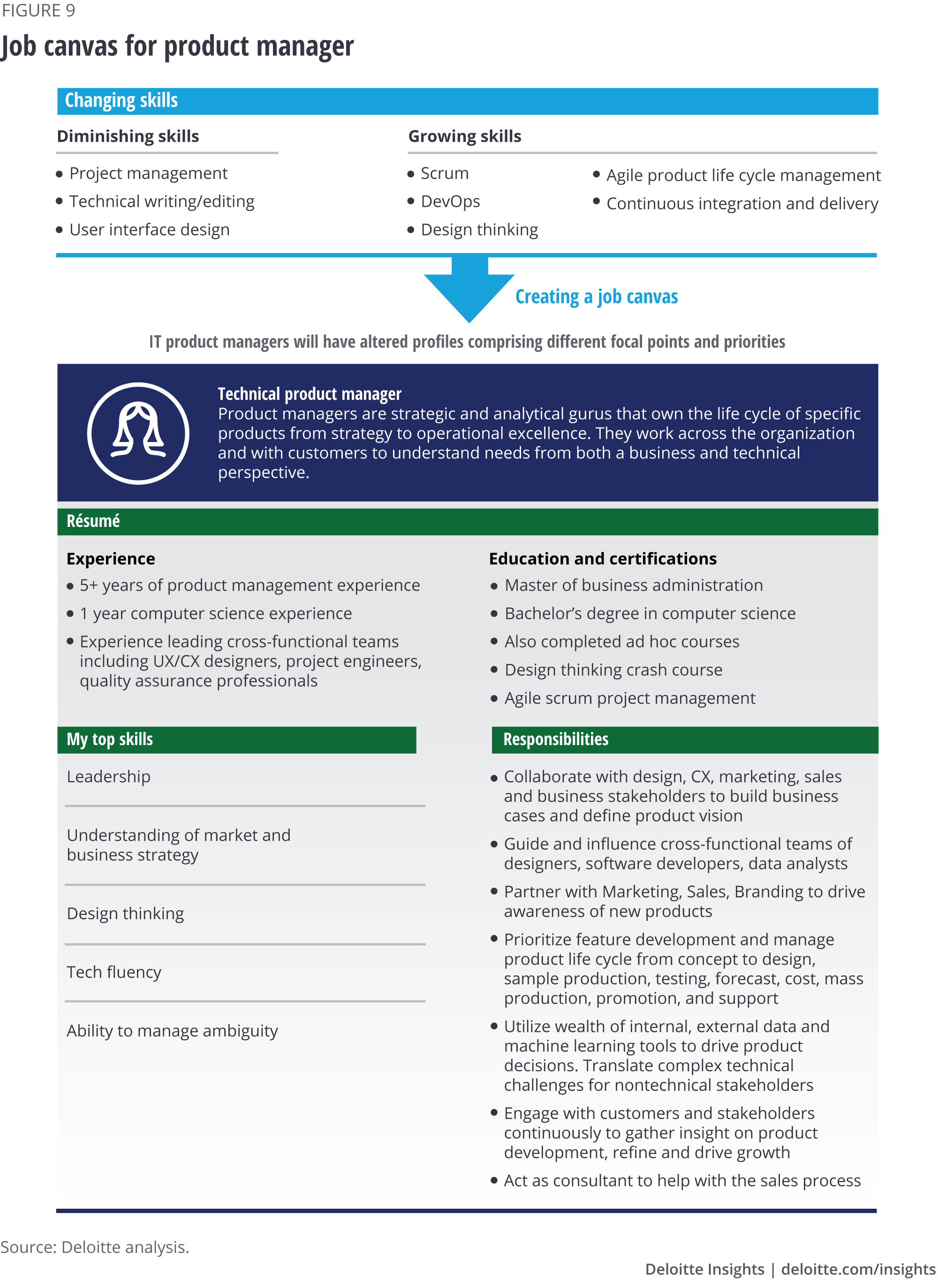
For product managers, skills that likely will diminish in importance include project management, technical writing and editing, and user interface design. On the other hand, scrum, DevOps, design thinking, Agile product life cycle management, and continuous integration and delivery will become more important skills (figure 9). Similarly, as product delivery and operations evolve, Agile portfolio managers will need to hone their capabilities in product testing, scrum and DevOps, data analysis, product management, customer contact, product improvement, and prototyping. They will likely have less need for skills such as project management, process engineering, systems integration, and component design (figure 10).
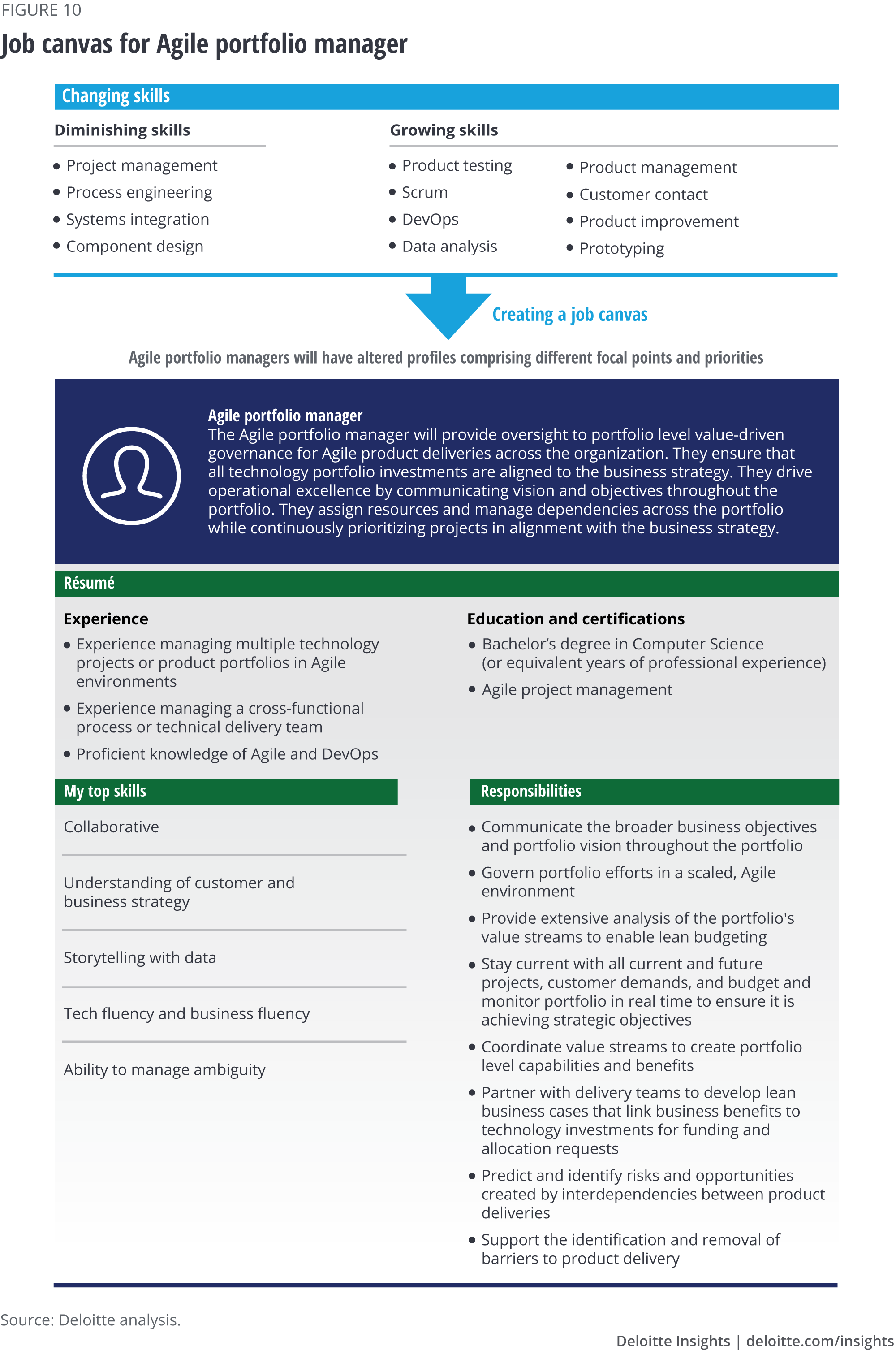
Workplace: From location-centric to relationship-oriented
The evolution of the work and workforce should be supported by targeted location strategies, as well as flexible physical and virtual workplaces. Fixed, uncompromising workplaces may need to evolve to virtual workplaces that leverage advanced mobility and connectivity, collaboration tools, and emerging technologies such as virtual and augmented reality that help improve collaboration and integrate workers from all segments of the open talent continuum.
“When it comes to the workplace of the future, physical proximity is going to matter less and less,” says Stella Ward, chief digital officer of Canterbury and West Coast District Health Boards, New Zealand. “There are so many collaboration tools out there to help teams get work done remotely. The challenge is identifying the right tools and making sure our employees know how to use them to maximize efficiency.”25
However, that doesn’t always mean face-to-face connections or the offices that host them are unneeded, although they may be designed differently. In fact, technology and business teams may require closer physical proximity than in the past. “Working in the office is about building relationships and trust between team members. When team members feel connected and trust each other, productivity increases,” says MassMutual’s Parent. “Good collaboration tools will help sustain this productive collaboration for longer periods of time when people cannot be regularly colocated but teams will still need to physically come together periodically.”26
Such workplaces likely will need to be flexibly designed to encourage collaboration and innovation to drive joint creation of business value. When considering a workplace strategy, leaders can ask questions about workspaces, collaboration, and culture (figure 11). Each is discussed below in greater detail.
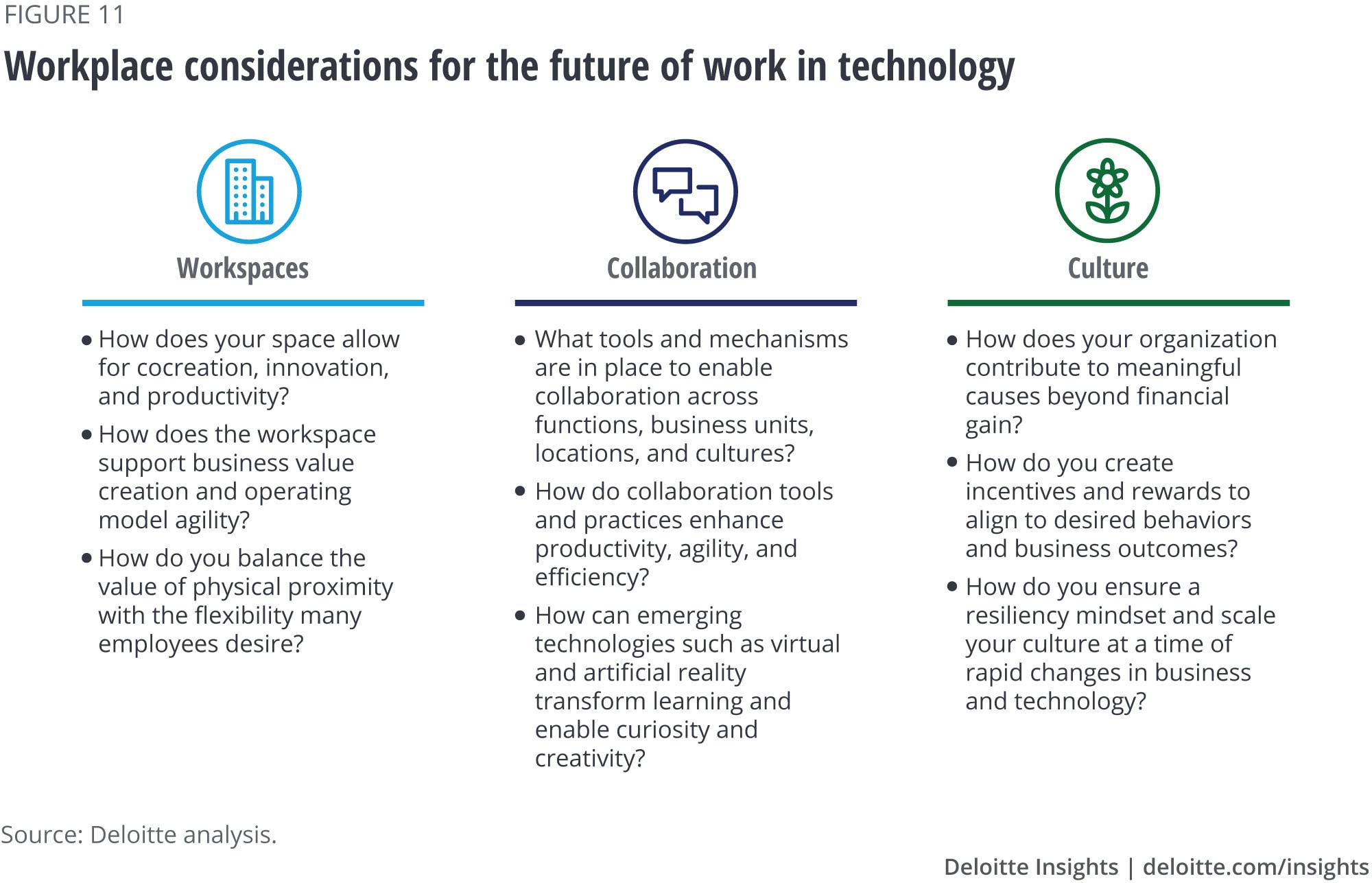
Creating workspaces for cocreation
The mandate to cocreate technology solutions likely would require collaboration among business and technology functions. Collaboration could be virtual or in-person depending on the role, scope of work, and activity. Leaders can strive to create physical and virtual workspaces that encourage teamwork and connections but acknowledge the need for deep individual work.
While a healthy portion of the workforce already has flexible work arrangements, leaders may need to carefully balance the strategies for leveraging flexible, remote, and virtual workers and providing physical proximity and colocation to spark innovation, diversity of thought, and unplanned connections.
Mechanisms that can enable customer participation in the cocreation process are important. This can help technology and business teams gather customer feedback, incorporate it into each release of product design, and engage the customer to communicate new features and availability of updates as a result of their feedback and consumption.
Collaboration tools and practices enhance productivity, creativity, value, and meaning
Video conferencing, online collaboration platforms, and other tools have revolutionized organizations’ ability to seamlessly collaborate on a global basis. As the work of technology evolves, collaboration tools likely will become critical; entire organizations may rely on them. Leaders should stay ahead of workers’ communication and collaboration needs and constantly evaluate tools that could enhance productivity, increase transparency and collaboration, inspire more creative results, and enable more meaningful connections—ultimately enabling teams to drive new sources of value.
Plan and execute cautiously so that these tools don’t become a productivity drain. One survey of 2,000 workers found that most use an average of four collaboration apps; 20 percent use six or more. Sixty-eight percent of employees say they toggle between apps up to 10 times per hour; about the same percentage (69 percent) say they waste up to an hour every day switching among apps.27 The American Psychological Association has found that employees experience a 40 percent drop in productivity each time they switch tasks.28
Adoption of collaboration-enhancing processes and practices can also be valuable. Agile methods such as daily stand-ups/scrum meetings, ongoing feedback loops, transparency, and joint accountability can help foster effective collaboration. And activity-based training, pairing, and rotation programs, and training for conflict resolution and growth mindset are other practices leaders can consider as they aim to integrate collaboration into the workplace and work activities.
Creating a culture of performance, purpose, and meaning
Steve Jobs famously said that A players attract other A players.29 Occasionally, B players may convince a high performer to join the organization, but to consistently acquire and retain top talent, businesses need a supportive, engaging culture. The global CIO survey demonstrated that culture—the organization’s deeply rooted beliefs and behaviors—is a key distinguishing factor for digital vanguard organizations,30 yet many participants in the 2019 Deloitte Global Human Capital Trends Survey rated their organizations only somewhat or not effective on attributes related to culture and experience, including providing meaningful work (37 percent) and maintaining positive work environment (41 percent).31
Leaders can nurture and curate a culture to align with desired behaviors and outcomes. For the technology work of the future, cultural attributes such as collaboration, empathy, creativity, and agility likely will be significantly more important than they are today. Increasingly, social purpose and meaning are playing a significant role in organizational culture, due in part to pressure from workers, especially millennials and Generation Z: Forty-two percent of CIOs who participated in one survey say pressure from employees is a major motivator.32
As they seek to develop organizational cultures that support their business strategies, leaders should consider whether the current culture, incentives, behaviors, and leadership align with the new model. They can also determine whether certain policies, mandates, or corporate constraints hinder productivity, agility, and growth. For technology, iterative work processes often require integrated and ongoing performance and development conversations to be embedded into the flow of work. Rewards are based on teamwork, the attainment of shared goals, and customer intimacy rather than operational excellence.
3 key implications for the future of work transformation
Financial planning. Changes in technology—and corresponding changes in the work, workforce, and workplace—may have significant financial implications that should be understood early in the process. Engage necessary stakeholders to gain consensus on issues such as capitalization versus the expense model, as well as internal versus external spending.
Ecosystem orchestration. The current procurement mindset often benefits the lowest cost provider, leads to transactional relationships, and binds the organization to multiyear commitments. And as the shelf life of skills moves from a lifetime to a few years, organizations cannot always rely on captive talent to do their work. Leaders are quickly realizing they should reimagine their ecosystems as sources of value cocreation, revenue, and augmentation of internal talent and skills. Businesses are evolving from members of a linear value chain that adds incremental value to participants in a much broader ecosystem of technology disrupters, incubators, startups, business partners, suppliers, and customers that cocreates business solutions, uncovers new opportunities, and delivers competitive advantage. One large distribution company built a platform that allowed real-time information to its suppliers and an integrated portal for its global distribution network that created efficiencies, reduced inventories, and increased profits across the entire ecosystem.
Technology work in the business. Pervasiveness of technology is impacting work outside of traditional boundaries of IT. What might once have been viewed as a traditional business role is now becoming very tech-centric. The impact of the changes in technology work, workforce, and workplace on business roles should also be considered.
Imagine, compose, and activate the future of work
Given the complexity of the converging disciplines, new talent models, spectrum of human–machine collaboration, and other variables in this shift, developing and executing the organization’s future of work strategy may seem paralyzing. To help leaders get started, we suggest using a method we’ve called “Imagine-Compose-Activate.”
Instead of getting bogged down in solving an immediate problem, start by imagining the organization’s future in the three- to five-year time frame. Imagine the future of work without constraints; restrictions typically evolve over time.33 If there were no budget, staffing, or other constraints, what would the business look like? How will it drive value and provide meaningful work?
Composing the work and work outcomes can help businesses lay the foundation for work, workforce, and workplace components. Analyze and redesign work, workforce, and workplace options that take advantage of automation, alternative talent sources, and collaborative workplaces.
Finally, activate the future of work by initiating changes to the workforce and workplace and determining how to measure and report outcomes. This includes realigning operating model, culture, talent development, and leadership.
Lessons from leaders
The executives we interviewed provided three overarching lessons to help enable the Imagine-Compose-Activate process.
Zoom out first. Technology leaders are problem-solvers who tend to “zoom in” on problems with the intent of quickly solving them. Instead of narrowing in on and trying to resolve specific pain points related to the future of work, consider first looking at the big picture, holistically taking into account changes in work, workforce, and workplace. “Zooming out” three to five years and envisioning a future without bounds can help leaders imagine and define the art of the possible without the current constraints.34 This could help leaders get “unstuck” from the present and drive a transformative mindset that could clarify the unrealized potential of work, workforce, and workplace.
Access, curate, and engage talent. The traditional talent management mindset focused on attracting, developing, and retaining needed talent. The evolution of work, workforce, and workplace suggests the Attract-Develop-Retain model may have run its course. Consider instead the Access-Curate-Engage approach, in which organizations access talent on the open continuum, curate consumer-grade learning experiences that can enable technology athletes to build skills in real time, and engage talent by realigning rewards, incentives, and leadership to support and enable idea generation, cocreation, collaboration, accountability, and transparency.
Iterate, deliver, and repeat. We can’t emphasize this enough: The future of work transformation is a journey, not a destination. Continually iterate the work, workforce, and workplace models to account for changing business and technology landscapes. As new technologies and business models emerge, the work of technology will continually change and leaders in technology organizations likely will need to adapt quickly.
Additional key recommendations
Shifts matter: Move from IT capabilities to work outcomes. Technology work has often been traditionally performed by a centralized IT function and “thrown over the wall” to the business to confirm whether promised results were achieved. To kick-start a business mindset change, we purposefully have moved away from the traditional notion of IT capabilities in this report and embraced the term “work outcomes.” The concept of work outcomes holds both technology and business resources accountable for product outcomes as well as adjustments and iterations that allow for continuous business value.
Bias toward speed and progress, not perfection. Recognize that speed and time to market are often key to competitiveness and cocreation. Releasing and iterating a minimally viable product based on customer feedback is fast becoming the norm. Technology work of the future is more akin to building speed boats than large naval vessels. Reliability, security, and resilience are still required, but flexibility, agility, and speed typically are more important.
Embrace cocreation at the team, enterprise, and ecosystem levels. The future of work is not a solo journey. Partner with other executive leaders and business and functional executives and equip them with the knowledge and ability to make informed technology decisions. The global CIO survey found that technology leaders who elevate the tech fluency of business counterparts are likely to have deeper and more influential relationships with their peers.35 The three most important allies for technology leaders on this journey likely will be the finance, HR, and procurement leaders—help them become equally invested and accountable for the outcomes.
Iterate with end—the outcomes—in mind. This journey may be triggered by business reorganization, skills shortage, business realignment, office space redesign, or many other potential causes. Irrespective of its entry point, a business should define work outcomes before trying to transform the workforce or workplace. Jumping ahead to reskilling the workforce or redesigning the workplace without understanding the shift in technology work could create chaos and confusion. After establishing work outcomes, leaders can determine the tools, automation, workforce needs, and how to augment humans with machines. Work outcomes and workforce decisions together can help determine the type of physical workspace, collaboration tools, and culture needed to support the change.
Enable real-time learning. Gone are the days when professionals crafted and perfected their skills over decades, even lifetimes. An average employee may have multiple careers in an organization. To engage and retain high performers, leaders should develop continuous learning programs that provide real-time skills acquisition, on-the-job training, and experience-based rapid knowledge transfer.
Stay informed through tech sensing. The increasing speed of technology change can make it difficult to stay abreast of advances. Technology leaders can keep informed of emerging technology trends and their business implications. Many leverage partner ecosystems to tap into new technologies, while others collaborate with universities and incubation hubs or invest in startups. Knowledge acquired as the result of such “tech sensing” approaches should be disseminated throughout the organization to help increase technology fluency.
Align with purpose. External corporate brand, internal culture, and the technology organization’s mission should align to a higher purpose. Top talent often wants to work for companies whose ambition, passion, and purpose rise above economic considerations. They’re seeking organizations that believe in and significantly contribute to meaningful causes. Authentically aligning the organization to environmental issues, human development, public health, or other relevant cause that can help bring meaning to work can directly impact talent recruitment.
Tolerate calculated risk. Typically, technology leaders avoid or minimize risk while business leaders seek to maximize value while taking calculated risks—two perspectives that are often at odds. Leaders shaping the future of work in technology can devise ways to consistently understand and agree on risk appetite with key stakeholders and make decisions and course corrections accordingly. Embrace ambiguity, uncertainty, and experimentation and avoid making risk decisions on behalf of the business. Instead, collaborate to make more informed, data-driven decisions.
Think big to create an audacious future. Focusing on the big picture, rather than a single tool or solution, can help leaders take the first steps toward creating the future of work. Foundational change takes time and persistent work across multiple dimensions. Simply reskilling staff, bringing on a new leadership team, or automating existing work likely will not alleviate current challenges. Instead, a holistic plan that employs multiple work, workforce, and workplace strategies has a higher likelihood of success.
© 2021. See Terms of Use for more information.
Read more from CIO Insider
-
CIO Insider Collection
-
Reimagining the role of technology Article5 years ago
-
Beyond innovation by shotgun Article5 years ago
-
Technology and the boardroom: A CIO’s guide to engaging the board Article6 years ago
-
Digital vanguard organizations Infographic6 years ago








